The Lairig Ghru is the most prominent pass through the centre of the Cairngorms National Park. A road has never been built through the middle of it. It used to be a drovers’ pass for taking the cattle to market, but is now a route for walkers and cyclists to pass through the centre of the Cairngorms National Park. It runs roughly north-south from Aviemore to Braemar and is a prominent feature on the mountain skyline from Aviemore.
Hiking into the heart of the Cairngorms
Photo credit: David Mansell
The main roads all circumnavigate the Cairngorms National Park which means that to drive from one side near Braemar, to the other, near Aviemore, will take close to 2 hours. To access either end of the route you’ll need to make a massive diversion on public transport via either Perth or Aberdeen, as there is no longer a bus service from Grantown on Spey to Braemar. (The Council sponsored a bus route from Grantown to Braemar – the Heather Hopper, but when funding ran out no one took the route on.)
The route for hikers through the pass is 19 miles from Linn of Dee to Whitewell. However, if you plan to organise your own walk you’ll need to arrange for someone else to make the 2 hour diversion to the other end to meet you and take you back to your start point, or allow for the extra walk from Linn of Dee to Braemar, an additional 18 miles and perhaps the additional mile to Coylumbridge (and possibly from there to Aviemore if you miss the bus.
Traversing the Cairngorms on the classic Lairig Ghru route, which used to be a drovers road
Photo Credit: Scot Mountain Holidays
The hike is 19 miles (minimum) and passes through the main Cairngorm massif under Ben Macdui, Braeriach and Carn Toul. The high point is at approximately 2000ft, so not a mean feat. The high point is within sight of Aviemore and towards the end of the south – north route we advise. You’ll finish the hike within sight of the Lairig Ghru itself.
Scot Mountain Holidays have put together a package for hikers to make the Lairig Ghru accessible to small groups. We can accommodate up to 8 people in our own transport, but have also arranged the trip for larger groups with additional transport. Max: 14
We offer:
The trip is very popular with couples, but priced on our website for 4 or more people. Please enquire directly with us if your group is smaller than 4 people. We’ll quote you directly.
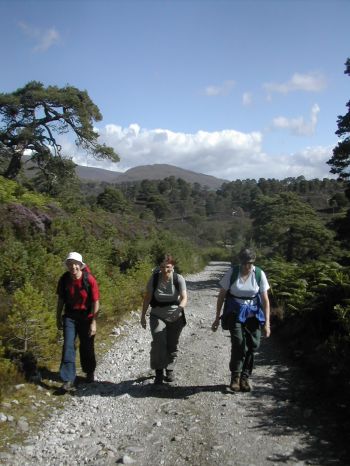
Photo credit: Scot Mountain Holidays
Hiking the Lairig Ghru is a challenge in itself which anyone can complete as a charity challenge. It is a well-known and clearly defined goal familiar to most Scottish hikers, though has less of a reputation south of the border. Some mountain rescue teams already offer the route as an organised challenge event. Please contact us if you are proposing to hike the Lairig Ghru to raise funds for a charity.
We can also offer the Lairig Ghru as a guided option which might be a good option if you are on your own as we are not able to combine self-guided groups for insurance reasons. Please phone: 01479 831 331 for full details or visit our contact us page.
We’re often asked when it is a good time to come to Scotland. For us every season has it’s advantages and perhaps disadvantages, depending on your point of view. There are definitely certain times of year which are better for hiking than others. There are also certain times of year when it is best to be in particular areas. If you’re a weather geek, you can find out for yourself which are statistically the best weeks to plan your trip by studying the “weather singularities”.
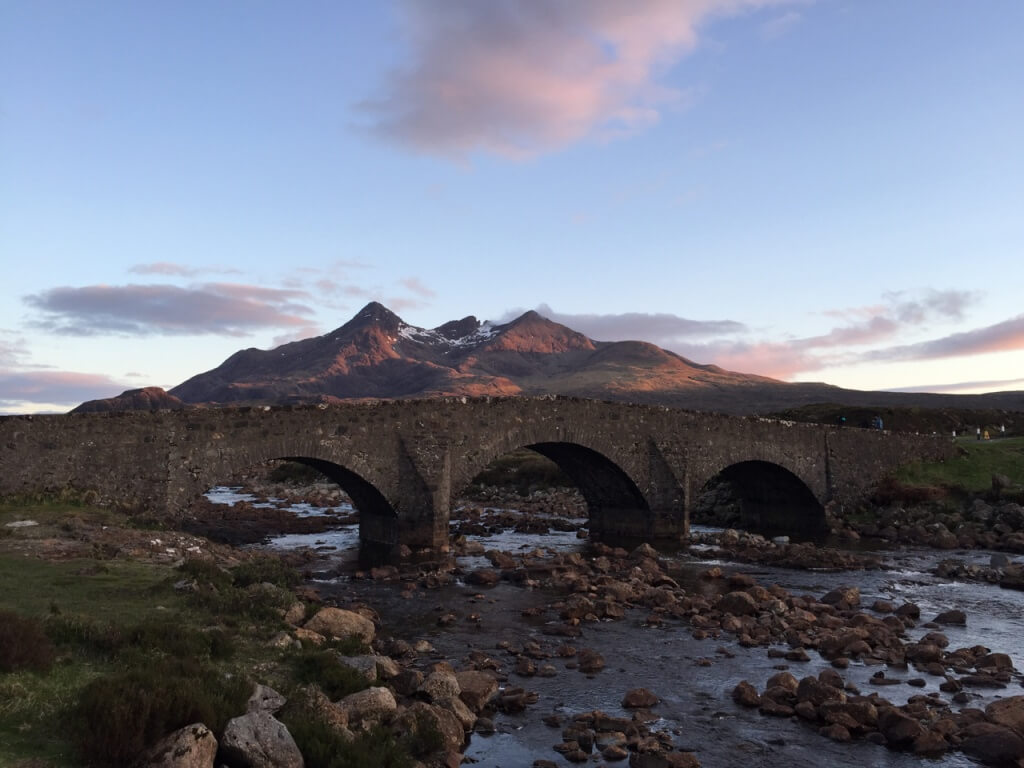
Sunset over Am Basteir from Sligachan on the Isle of Skye during the Skye Munros itinerary
Weather singularities are statistically proven times of year when the same weather tends to re-occur e.g. always dry that week. In fact, these have been noted so frequently in some cases that they even have traditional names like: “St. Luke’s Summer” or “Old Wives Summer”. Andy has studied the weather very closely and plans our west coast trips around the times of year when we are statistically likely to have the best conditions. This is why one of the most frequent comments we have as guests depart is: “Haven’t we been lucky with the weather?” Mind you, that might also be due to the fact that they come expecting to be rained on every day. Any day which is dry is considered to be a bonus!
You can choose by season which would be the best time of year to plan your trip. Whether it will rain or not, is not necessarily the only factor which would influence your decision. You may also want to consider what wildlife will be around or how long the day will be.
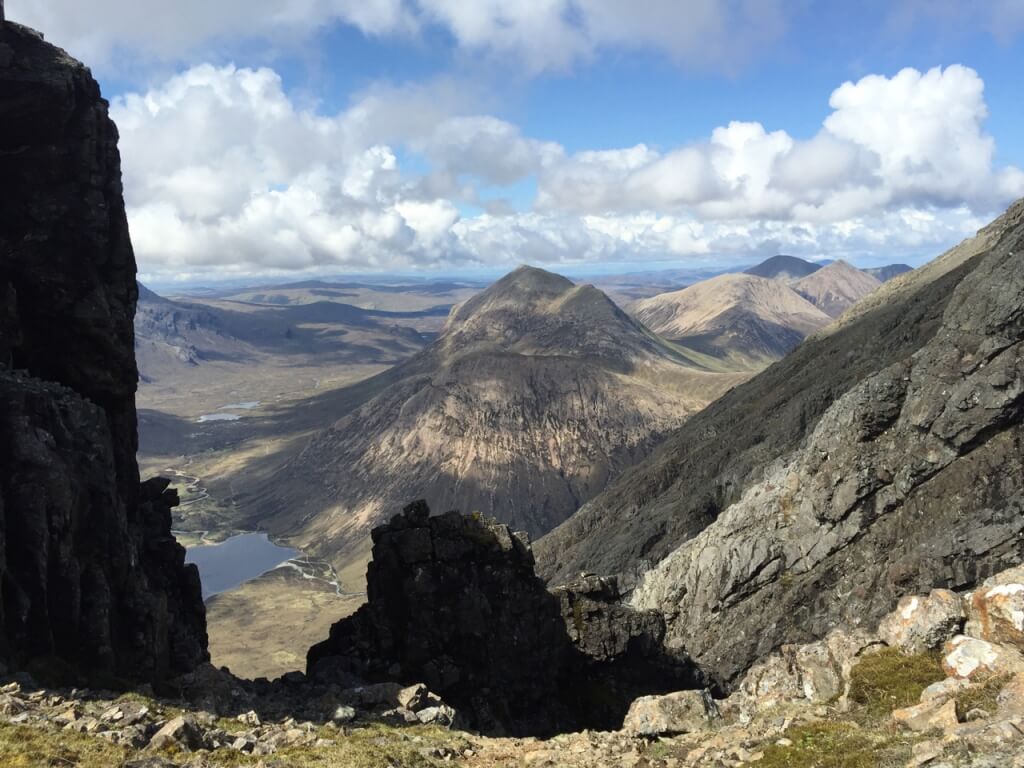
Spectacular views for the Cuillins on the Isle of Skye
The division for the Spring months may be surprising, but here in the Highlands of Scotland, Spring doesn’t really arrive until April. Skye is a wee bit more of a warmer climate than by our home base in the Cairngorms. Being closer to the sea, Spring can arrive earlier and the wildflowers will often start to put on an appearance in March. Our Spring months are more often than not April, May and June. Spring is an amazing time to visit Skye, in particular, as more often than not the dreaded midge has not awoken from her winter slumbers; the days are long and the weather is frequently dry and more often than not, sunny.
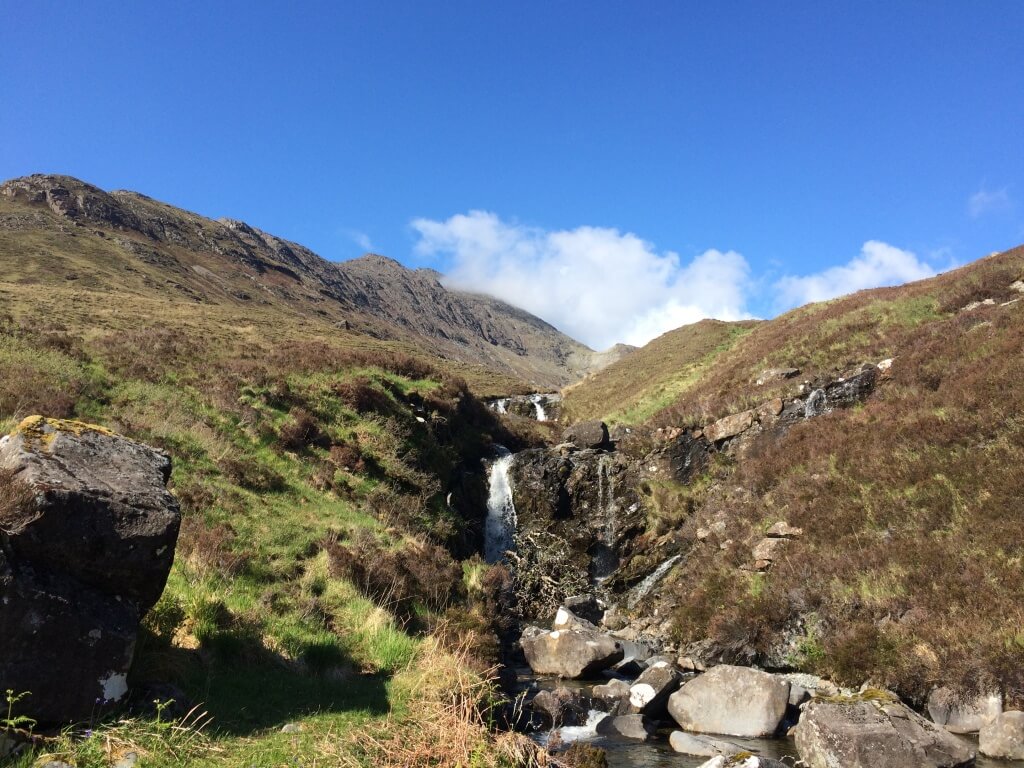
It’s hard hiking the Munros on Skye but all the views make is well-worth it in blue sky weather.
The seabirds, like the gannets and guillemots’ start to return to the cliffs surrounding Skye in Spring. Sea Eagles and Golden Eagles nest on Skye. The Sea Eagles tend to lay their eggs early in the Spring with a 6 week incubation period. The chicks could well be hatching around the time we will be on Skye in May. Once the chicks hatch the Sea Eagles and Golden Eagles are very active hunting for food to feed them. Spring is a very good time to spot the eagles.
Baby lambs will be playing in the fields. Skye is certainly a good place to spot lambs. Plenty of sheep in the lower fields of Skye as well as a thriving wood industry producing both yarn and cloth.
Another advantage of Spring, particularly May, is that the daylight hours are so long. Though we’re not quite at the longest day (mid-June), you can still be out at 10pm without the need for a headtorch.
Seeing the sun still up at 10pm and 3am or earlier is something which astounds most tourists. Be sure to make sure your accommodation has good curtains though if you’d rather have a good night’s sleep. If the sun is out, it can be glaring at 4am and most of us don’t appreciate that when we’d rather be sleeping.
July is the month to see the best of the orchids.
In August, there are plenty of wading birds to be found on the shores of the lochs and the heather is out in full bloom turning the sides of the hills purple. It’s also a really good time to spot whales, dolphins and porpoises.
The biggest disadvantage of visiting Skye in the height of summer is the sheer volume of tourists with the same idea. It can be extremely difficult to find accommodation and the road’s there just aren’t built for the volume of traffic.
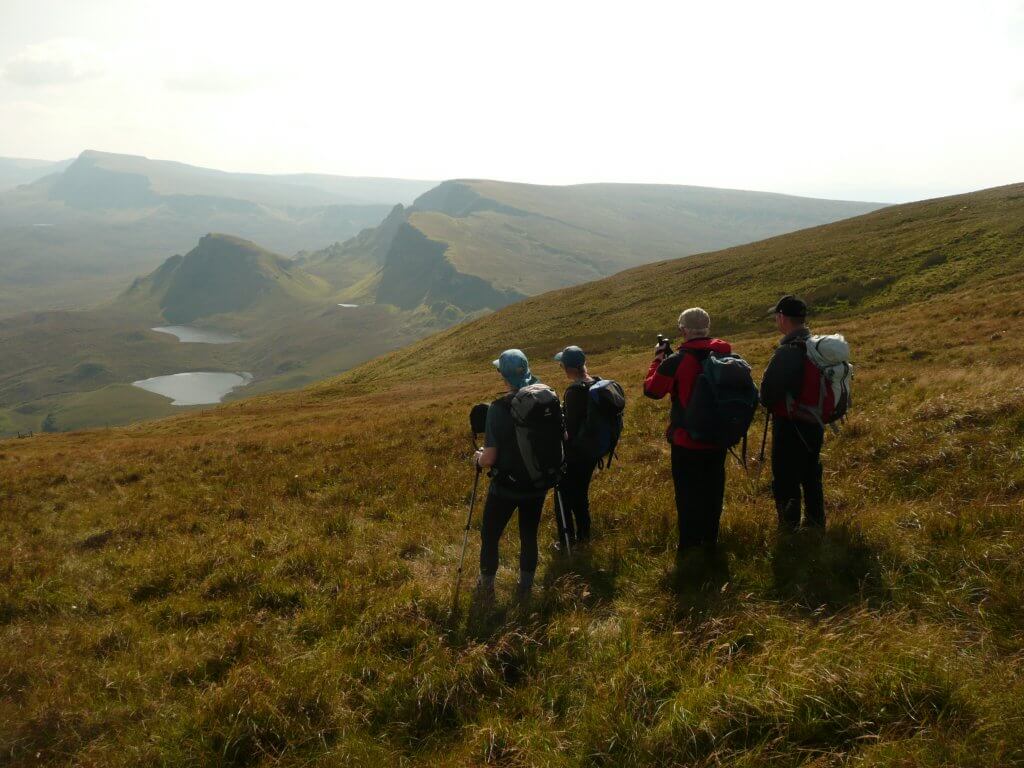
The Trotternish ridge on the isle of Skye
October is far and away the best time to spot the northern lights from Skye and November is the time to see the fireworks display at Dunvegan Castle. The display includes setting fire to a Viking longship. The difficulty for hikers though is that the sun sets before 5pm meaning that it is difficult, but not impossible, to complete a full mountain day in the light. The plus side though is that both sun rise and sun set can be glorious. It’s much easier to spot a good sunrise when it takes place around 7am rather than in the early hours of the morning.
December is an extremely good time to spot the sea eagles who are in the midst of their mating rituals now. The eagles will be soaring in the sky displaying and getting ready to pair up. Winter can also be a very good time to spot red deer who tend to come lower down the hills and can be spotted at the roadside in search of food. It’s also the best time to look for otters.
We’ve picked a prime week in May to visit Skye and pick off the Cuillin Munros. The guided trip will be fully inclusive of accommodation and meals as well as transport to the walks and pick up from Inverness airport, Fort William and Aviemore station depending on your travel arrangements.
We also have our Superlative Skye trip available to groups of 4 or more people. It’s not currently scheduled and our calendar for 2017 is rapidly filling up so do get in touch soon if you’re hoping for us to run this itinerary. We could even make a plan for 2018!
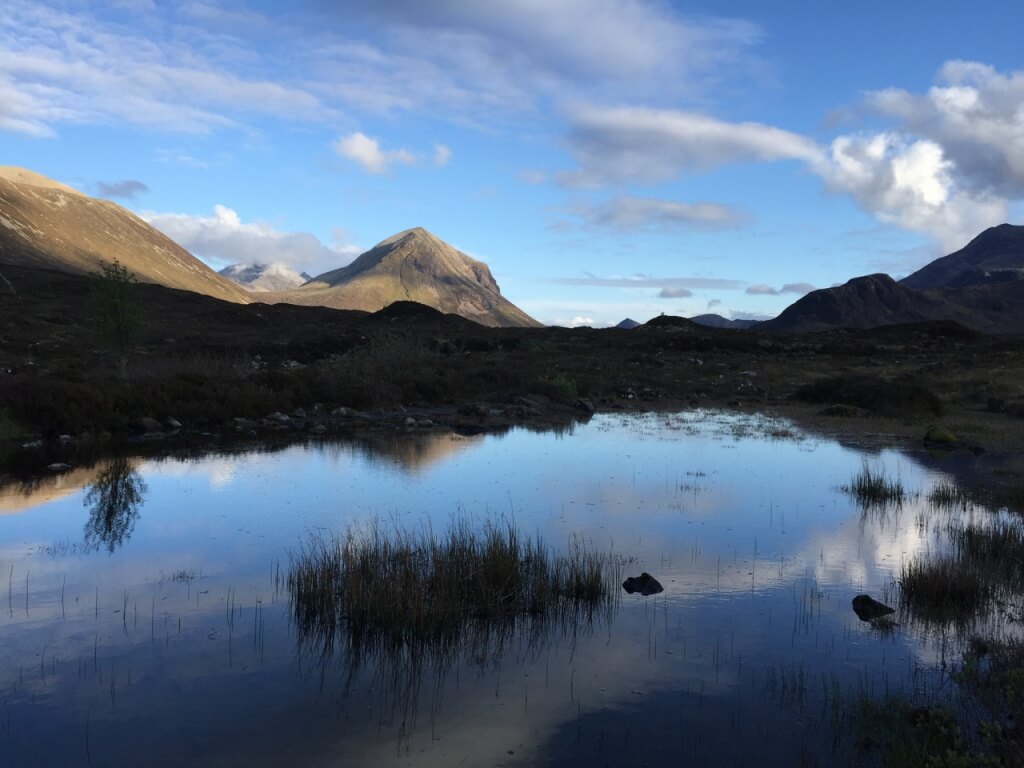
Perfect weather in May 2017 when our group picked off all the Munro summits.
Making the most of your time on Skye
When to visit the Glendale area of Skye
The weather statistics for Glendale
WOW Scotland: the best time of year to visit the Highlands of Scotland
Where should you go for the best autumnal pictures you can get in the Cairngorms National Park? It’s a secret! But one we’re willing to share for our local area. We don’t think it will spoil things too desperately as you can only get to this route if you’re driving and there is no parking for buses or coaches.
If you come to stay at Fraoch Lodge, no doubt you’ll be looking for some hiking advice. It’s only natural, we are very knowledgeable, especially as Andy is a mountain leader, with a well-deserved reputation as a walking guide. Even our international guests in the height of the summer months are looking for some help finding good quality hikes.
Is this the prettiest time to visit the Cairngorms? There might be some debate about that as many find the snow-clad hills of winter stunning. However, there can be no debate about this being the most colourful time of year.
Our top pick would be a hike in Glen Feshie. Glen Feshie is definitely one of the prettiest parts of the northern area of the National Park. If you’re hiking a there and back route along the bottom of the glen, this is a route we would recommend for almost all abilities and can also be turned into a mountain biking adventure.
For a more adventurous route, or to turn the hike into a circuit feel free to consult with Andy or book his services as a guide.
Start of the hike: Achlean Car Park (Start Grid Ref NN850985)
Finish of the hike: Achlean Car Park
There’s no public transport option to access the start of this hike.
Total route includes ascent of the Munro summit of Mullach Clach a’Blair.
Habitats: Pine Forest, moorland, mountain tundra
Distance: 22.5km / 14 miles
Time: 7 – 8 hours
Ascent: 785m
If you don’t want to go all the way to the summit of Mullach Clach a Blair, it is still a perfectly lovely walk to go along the river Feshie as far as you want or until the bothy before returning to your car. You won’t pass through as many habitats and won’t come across ptarmigan, but you might still see roe or even red deer, numerous forest birds including the ever present chaffinches and possibly Scottish crossbills if you’re lucky.
You might also want to consider a mid-level hike. Watch out for our blog on the most popular hike in the Cairngorms: Meall a’Bhucaille.
Ask what you might need in advance; don’t be worried if you’re not an experienced mountaineer as there will still be lots available to do; go for it!
All content © Copyright Scot Mountain Holidays 2025
Responsive web design by Summit Web Solutions